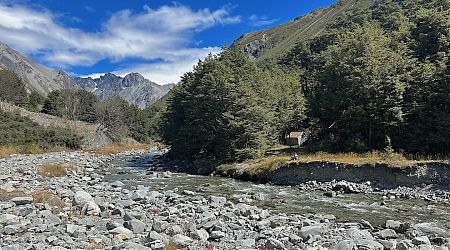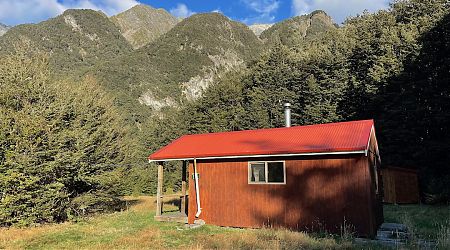South Canterbury huts and campsites
This is Big River territory, with the Southern Alps / Kā Tiritiri o te Moana to the west and the Canterbury Plains to the east.
Whereas the huts to the north tend to be old New Zealand Forest Service deer cullers huts or DOC recreational huts, once you get into the midsection of the South Island, they can have more varied origins.
Old musterers’ huts. Serviced Alpine huts. Privately owned huts from the Canterbury Mountaineering Club or Canterbury University Tramping Club, as well as the Forest Service or DOC varieties.
The big rivers like the Rakaia and Rangitata Rivers can be difficult to cross due to the water volume and the flow’s steepness. The ranges between them may require high pass crossings.
Some huts, like Mueller Hut, are very popular, and the ones on Te Araroa, like Crooked Spur Hut, are regularly visited, but others, such as Back Basin Hide or Dog Kennel Bivvy much less so.
So, here is a representative sample.
A Frame Hut might come in handy if the weather packs it in.
Famous for the bath, but don’t use all the water from the tanks as it is a long and steep drop down to the river.
Is a totally spectacular location, and quite a decent size for two.
The hut is in good nick for such an old hut.
A typical SF70 New Zealand Forest Service hut in reasonable condition, with large porches on the front and east side added.
The view of the Upper Huxley valley basin from the helicopter landing pad is extraordinary.
Camp Stream Hut is an 1898 musterers’ hut that has been DOC-ified over the years, with bunks and mattresses added.
Comyns Hut is a musterers’ hut at the northern end of the famous “63 river crossings in an afternoon” that are either just completed or to be contemplated.
Crooked Spur Hut is another one of the character-filled, old musterers’ huts that populate this part of Te Araroa.
Cullers Hut is mostly used by hunters and has been partially renovated.
One of the most pleasant huts in the Havelock River Valley.
One of the best examples of a two-bunk New Zealand Forest Service bivvy in near original condition around.
It’s right in the heart of tahr and deer territory, so no surprise it’s often used by hunters, although also finds favour with mountain climbers as a base camp.
Simply full-on “character”. Not far removed from an actual dog kennel.
Lots of character here, including plenty of historic graffiti on the internal walls.
Built by the New Zealand Alpine Club in 1938 to provide a base for climbing the many peaks in the vicinity. Really well looked after by the current members.
A tight little four bunker with no heating, so winter accommodation will require a decent sleeping bag.
Fairly minimal amenities, windows or mattresses are omitted, but it does have a roof.
A lovely little New Zealand Forest Service bivvy built in 1963.
A reinforced blockwork shoebox with a more attractive ply-lined interior.
With a colour scheme that makes it stand out in the landscape.
A good easy tramp for teenagers for the weekend, and an introduction to hut life.
A great little four bunk hut in fairly original condition is set on a knoll in a small clearing.
Just a bit off the main Te Araroa track this is another old musterers’ hut.
A typical New Zealand Forest Service SF 70 six-bunk hut in good condition that was relocated here in the 1980s.
The hut is in good original condition, although a much-needed roof light has been added.
Being a hut that can be reached by four-wheel-drive, it suffers a little from having many shortstay visitors, of whom few stay the night.
One of the great New Zealand outdoor day trips or overnighters, for the energetic.
A lovely bivvy in great condition.
Within the shadow of the Main Huxley Forks Hut.
It’s a bush-built beauty, with a local beech sapling structure, a dirt floor, and canvas or hessian bunks.
In recent years it has been substantially renovated on the interior, the exterior has been painted, and the water supply worked out.
A hut originally built for a failed tourist venture to take tourists to Mount Cook via Barron Saddle at the head of the adjacent Dobson River, and thence down the Mueller Glacier. In their tweeds and petticoats.
Royal Hut is another old musterers’ hut from station days but it has the usual facilities you expect in a DOC hut.
So that’s the wood shed, where is the hut?
One of the original New Zealand Forest Service huts in the area has been extended and modified at some stage in the past.
It’s a damp stroll in, with much of the way swampy, but at least it’s reasonably level.
A well cared for Canterbury Mountain Club hut that is available for use by the public.
Stodys is an old musterer’s hut that has been recently renovated to give it another few decades of life.
There’s part of the stone bit left, the fireplace end, but Stone Hut has been hit by avalanches in the past, not worth staying here in the winter when there is snow on the hills.
An historic two bunk hut that is acceptable accommodation in an emergency.
The views are terrific. And better now all the actual Pines have been harvested.
Tin Hut is an old dusty, musty musterer’s hut that is available for use by the public. The graffiti on the hut exterior makes for interesting reading.
Mostly used by hunters and occasional long-distance mountain trekkers, or a few trampers who engage with the Moa Saddle circuit.
Dirt floor. Bush cut local timber structure. Huge fireplace. Canvas bunks. No insulation, and plenty of ventilation.
The lack of heating is a possible disincentive to staying in cooler months, although the full complement of three visitors would be cosy in the confined space.
The bog is across a bog.














































